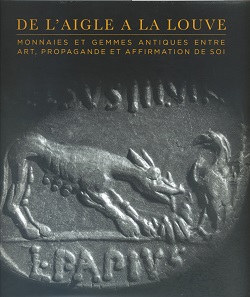by Ursula Kampmann
Translated by Leonie Schulze
August 23, 2018 – “If a collector has to sell his collection, it surely is a necessity and it does not go about without deep regret. He clings to the idea that those objects, which were so dear to his heart, will now make other coin enthusiasts happy. If a museum is the one who becomes the guardian for future generations, he will soon get over the pain of separation.” I am convinced that as soon as Carlo-Maria Fallani receives his copy of the book titled “De l’aigle à la louve – monnaies et gemmes antiques entre art, progapande et affirmation de soi“, which was published on the initiative of Matteo Campagnolo, he will no longer think about how much he misses his collection because it could not have been honored with greater admiration.
Matteo Campagnolo in collaboration with Jacques Chamay and a group of his students, as well as Carina Weiß and Danielle Decrouez, Photos by Luigi Spina, De l’aigle à la louve. Monnaies et gemmes antiques entre art, propagande et affirmation de soi. 5 Continents Editions, Mailand 2018. 423 pp., fully illustrated, in color. Hardcover. 25,2 x 26,2 cm. ISBN: 88-7439-795-2. 90 euros.
In 2001, Carlo-Maria Fallani committed his collection of Roman Republican coins to the Musée d’art et d’histoire in Geneva. Matteo Campagnolo came up with the idea of not putting together yet another catalog, but instead presenting the animals depicted on the ancient coins and gems of the museum’s fantastic collection as a sort of numismatic bestiary. We owe it to the amazing – artistic, not numismatic – photographs of Luigi Spina that this has turned into a treat for both the eyes and the brain. The bibliophilic illustrated book, compiled with effort and affection, will probably first attract those who prefer looking over reading; but that is only the starting point: the interesting texts quickly capture your attention and allow for an understanding of the deeper meaning of the illustration, which the modern human being cannot deduce immediately.
For example, who still remembers today that the Greek word for butterfly once used to be psyche and that the same word denoted the soul which left the body of the dead. Only once you are aware of this can you properly understand the image on a gem depicting the head of a herm decorated with large wings of a butterfly.
Matteo Campagnolo was responsible for the texts in the book in collaboration with Jacques Chamay and a group of his students, as well as Carina Weiß and Danielle Decrouez. God knows they are not as simplistic as coffee table books are sometimes accused of being. On the contrary, references to iconography were excellently researched, ancient sources were collected, and the whole thing was written in easily readable French. Those who want to write about the duck or the turtle in the future absolutely have to read this book beforehand. It offers a good overview of what people knew (or did not know) and thought about this animal.
In short, this illustrated book is one of those books which tell the story of the joy a collector feels when looking at ancient coins. In other words, if you sometimes struggle with getting those around you excited about your field of collection, why don’t you put this book on a coffee table in your living room so that visitors start browsing through it, get stuck reading it and turn into coin collectors themselves.
You can purchase the book at 5 Continents Editions.
This publishing house also offers other interesting books on numismatic topics, for example a catalog of the seals from the George Zako collection, the catalog of late Roman and Byzantine weights, as well as the beautiful book “Héros Antiques” that juxtaposes a Flemish tapestry with objects from ancient times that were known at the time of its production.





